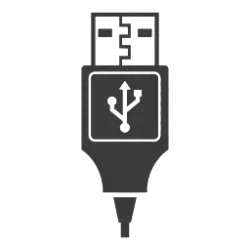I may have posted about this briefly before (don't recall for sure), but I thought that this is worth noting because I keep seeing people run into this.
Usually, a USB-C cable or adapter is bi-directional. You can plug in the cable one way, then unplug it, rotate 180 degrees, plug it back in, and get the same result. That turns out to be incorrect for some devices / cables / adapters.
I ran into this when I was using a USB-C to USB-A adapter to connect my SSD to a USB-A port. After doing so, I noticed that I was getting really slow transfer speeds. As I was experimenting, by pure luck, I flipped the cable plugging into my adapter and suddenly had high-speed data transfers. It took me a few seconds, but I suddenly realized what was happening - some adapters are NOT Bi-directional. So, while the USB cable may be capable of plugging in either way, the adapter requires that the USB-C cable be plugged in with one specific orientation otherwise it drops down to USB 2 speeds.
Here is an example of the type of adapter I was using:

Here is what to look for. Make sure that the listing for such a device specifically called out that the device is "bi-directional" or "bidirectional" like in this listing:

Some devices have an LED that will illuminate when you have a high-speed connection. Flip the USB cable and the LED turns off. Here is an image of one such device (a USB-C coupler in this case):

Summary: If you experience slow data rates on HDDs, SSDs, USB Ethernet adapters, etc. trying flipping the USB-C cable. What makes this issue so unintuitive is that the device works - it is just slow.
Usually, a USB-C cable or adapter is bi-directional. You can plug in the cable one way, then unplug it, rotate 180 degrees, plug it back in, and get the same result. That turns out to be incorrect for some devices / cables / adapters.
I ran into this when I was using a USB-C to USB-A adapter to connect my SSD to a USB-A port. After doing so, I noticed that I was getting really slow transfer speeds. As I was experimenting, by pure luck, I flipped the cable plugging into my adapter and suddenly had high-speed data transfers. It took me a few seconds, but I suddenly realized what was happening - some adapters are NOT Bi-directional. So, while the USB cable may be capable of plugging in either way, the adapter requires that the USB-C cable be plugged in with one specific orientation otherwise it drops down to USB 2 speeds.
Here is an example of the type of adapter I was using:

Here is what to look for. Make sure that the listing for such a device specifically called out that the device is "bi-directional" or "bidirectional" like in this listing:

Some devices have an LED that will illuminate when you have a high-speed connection. Flip the USB cable and the LED turns off. Here is an image of one such device (a USB-C coupler in this case):

Summary: If you experience slow data rates on HDDs, SSDs, USB Ethernet adapters, etc. trying flipping the USB-C cable. What makes this issue so unintuitive is that the device works - it is just slow.
Attachments
My Computers
System One System Two
-
- OS
- Win11 Pro 24H2
- Computer type
- PC/Desktop
- Manufacturer/Model
- Self-built
- CPU
- Intel i7 11700K
- Motherboard
- ASUS Prime Z590-A MB
- Memory
- 64GB (Waiting for warranty replacement of another 64GB for 128GB total)
- Graphics Card(s)
- No GPU - Built-in Intel Graphics
- Sound Card
- Integrated
- Monitor(s) Displays
- HP Envy 32
- Screen Resolution
- 2560 x 1440
- Hard Drives
- 1 x 1TB NVMe SSD
1 x 2TB NVMe SSD
1 x 4TB NVMe SSD
3 x 512GB 2.5" SSD
1 x 4TB 2.5" SSD
5 x 8TB Seagate Barracuda HDD
- PSU
- Corsair HX850i
- Case
- Corsair iCUE RGB 5000X mid tower case
- Cooling
- Noctua NF-S12A chromax.black.swap case fans (Qty. 7) & Home Computer Specifications, Configuration, and Usage Notes General Specifications ASUS Prime Z590-A motherboard, serial number M1M0KC222467ARP Intel Core i7-11700K CPU (11th Gen Rocket Lake / LGA 1200 Socket) 128GB Crucial Ballistix RGB DDR4 3200 MHz DRAM (4 x 32GB) Corsair iCUE RGB 5000X mid tower case Noctua NH-D15 chromax.black CPU cooler Noctua NF-S12A chromax.black.swap case fans (Qty. 7) & Corsair LL-120 RGB Fans (Qty. 3)
- Keyboard
- Corsair K70 Max RGB Magnetic Keyboard
- Mouse
- Logitech MX Master 3
- Internet Speed
- 1Gb Up / 1 Gb Down
- Browser
- Edge
- Antivirus
- Windows Defender
- Other Info
- The five 8TB drives and three 512GB SSDs are part of a DrivePool using StableBit DrivePool software. The three SSDs are devoted purely to caching for the 8TB drives. All of the important data is stored in triplicate so that I can withstand simultaneous failure of 2 disks.
Networking: 2.5Gbps Ethernet and WiFi 6e
-
- Operating System
- Win11 Pro 23H2
- Computer type
- Laptop
- Manufacturer/Model
- Lenovo ThinkBook 13x Gen 2
- CPU
- Intel i7-1255U
- Memory
- 16 GB
- Graphics card(s)
- Intel Iris Xe Graphics
- Sound Card
- Realtek® ALC3306-CG codec
- Monitor(s) Displays
- 13.3-inch IPS Display
- Screen Resolution
- WQXGA (2560 x 1600)
- Hard Drives
- 2 TB 4 x 4 NVMe SSD
- PSU
- USB-C / Thunderbolt 4 Power / Charging
- Keyboard
- Backlit, spill resistant keyboard
- Mouse
- Buttonless Glass Precision Touchpad
- Internet Speed
- 1Gb Up / 1Gb Down
- Browser
- Edge
- Antivirus
- Windows Defender
- Other Info
- WiFi 6e / Bluetooth 5.1 / Facial Recognition / Fingerprint Sensor / ToF (Time of Flight) Human Presence Sensor










